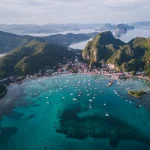
Discovering the Wonders of New Zealand: A Journey Through the Land of Kiwis and Stunning Scenery

New Zealand, located in the southwestern Pacific Ocean, is a country known for its stunning landscapes, diverse wildlife, and rich Maori culture. Comprised of two main islands, the North Island and the South Island, New Zealand offers a wide range of experiences for travelers. From the bustling city of Auckland to the geothermal wonders of Rotorua, and from the adventure capital of Queenstown to the breathtaking Fiordland National Park, there is something for everyone in this beautiful country.
New Zealand’s geography is incredibly diverse, with snow-capped mountains, pristine lakes, lush forests, and stunning coastlines. The country is also home to unique wildlife, including the kiwi bird, which has become a national symbol. In addition to its natural beauty, New Zealand has a rich cultural heritage. The Maori people have inhabited the islands for centuries and their traditions and customs are still celebrated today. The blend of Maori and European influences can be seen in the art, music, and cuisine of the country.
New Zealand has become a popular tourist destination for several reasons. Firstly, its natural beauty is unparalleled. From the stunning beaches of the Bay of Islands to the majestic fjords of Milford Sound, there are countless opportunities for outdoor adventures and breathtaking scenery. Secondly, New Zealand is known for its warm and welcoming people. Kiwis are known for their friendliness and hospitality, making visitors feel right at home. Lastly, New Zealand offers a wide range of activities for all types of travelers. Whether you’re an adrenaline junkie looking for extreme sports or a nature lover seeking tranquility, there is something for everyone in this incredible country.
Exploring the North Island: From Auckland to Rotorua and Beyond
The North Island of New Zealand is home to some of the country’s most vibrant cities and natural wonders. The journey begins in Auckland, known as the “City of Sails.” This bustling metropolis offers a mix of urban attractions and outdoor adventures. Visitors can explore the vibrant waterfront, visit the iconic Sky Tower for panoramic views of the city, or take a ferry to the nearby islands of Waiheke or Rangitoto.
From Auckland, a trip to the Bay of Islands is a must. This subtropical paradise is known for its crystal-clear waters, secluded beaches, and abundant marine life. Visitors can take a boat tour to explore the 144 islands that make up the bay, go snorkeling or diving in the pristine waters, or simply relax on one of the many golden beaches.
Next stop is Rotorua, a city famous for its geothermal activity and Maori culture. Here, visitors can witness geysers erupting, mud pools bubbling, and hot springs steaming. Rotorua is also home to several Maori villages where visitors can learn about traditional customs and watch cultural performances. The city is surrounded by beautiful lakes and forests, offering opportunities for hiking, mountain biking, and fishing.
Further south is Taupo, known as the adventure capital of the North Island. This picturesque town is located on the shores of Lake Taupo, New Zealand’s largest lake. Visitors can try their hand at trout fishing, take a scenic cruise on the lake, or go skydiving for an adrenaline rush. The nearby Tongariro National Park is a UNESCO World Heritage site and offers some of the best hiking in the country. The Tongariro Alpine Crossing is a popular day hike that takes visitors through volcanic landscapes and offers stunning views of Mount Ngauruhoe, also known as Mount Doom from “The Lord of the Rings” movies.
Discovering the South Island: From Christchurch to Queenstown and Beyond
The South Island of New Zealand is known for its dramatic landscapes and outdoor adventures. The journey begins in Christchurch, the largest city on the South Island. Known as the “Garden City,” Christchurch is home to beautiful parks, botanical gardens, and a vibrant arts scene. Visitors can take a punt ride on the Avon River, explore the historic Christchurch Cathedral, or visit the International Antarctic Centre.
From Christchurch, a trip to Marlborough is a must for wine lovers. This region is famous for its Sauvignon Blanc and offers numerous wineries for tastings and tours. Visitors can also explore the Marlborough Sounds, a network of sunken river valleys that create a stunning maze of waterways and islands. Kayaking, sailing, and hiking are popular activities in this area.
Next stop is Queenstown, often referred to as the adventure capital of the world. This picturesque town is nestled on the shores of Lake Wakatipu and surrounded by majestic mountains. Queenstown offers a wide range of adrenaline-pumping activities, including bungee jumping, skydiving, jet boating, and white-water rafting. For those seeking a more relaxed experience, there are also plenty of opportunities for hiking, golfing, or simply enjoying the stunning scenery.
Further south is Dunedin, a city with strong Scottish heritage and abundant wildlife. Visitors can explore the historic architecture of the city’s Victorian and Edwardian buildings, visit the famous Larnach Castle, or take a tour of Speight’s Brewery. The Otago Peninsula is home to several wildlife reserves where visitors can see penguins, seals, and albatross in their natural habitat.
Awe-Inspiring Landscapes: From Fiordland National Park to Mount Cook
New Zealand is renowned for its awe-inspiring landscapes, and some of the most breathtaking can be found in Fiordland National Park. Located in the southwest corner of the South Island, this UNESCO World Heritage site is home to Milford Sound and Doubtful Sound, two of the country’s most iconic fjords. Visitors can take a boat cruise through the fjords, kayak in the pristine waters, or hike one of the many trails that offer stunning views of the surrounding mountains and waterfalls.
Another must-visit destination is Mount Cook, New Zealand’s highest peak. Located in Aoraki/Mount Cook National Park, this majestic mountain offers a range of outdoor activities, including hiking, mountaineering, and stargazing. The park is also home to several glaciers, including the Tasman Glacier, which can be explored on guided tours.
For those seeking sun and sand, Abel Tasman National Park is the perfect destination. Located at the top of the South Island, this coastal paradise is known for its golden beaches, turquoise waters, and lush forests. Visitors can take a scenic boat cruise along the coastline, go kayaking or paddleboarding in the crystal-clear waters, or hike one of the many trails that wind through the park.
Tongariro National Park, located in the central North Island, is another must-visit destination for nature lovers. This UNESCO World Heritage site is home to three active volcanoes: Mount Tongariro, Mount Ngauruhoe, and Mount Ruapehu. The Tongariro Alpine Crossing is a popular day hike that takes visitors through volcanic landscapes, past emerald lakes, and offers stunning views of the surrounding mountains. The park also offers opportunities for skiing and snowboarding in winter.
Meeting the Locals: Experiencing the Warmth and Hospitality of Kiwis
One of the highlights of visiting New Zealand is experiencing the warmth and hospitality of its people. Kiwis are known for their friendliness and welcoming nature, making visitors feel right at home. The country’s culture is deeply rooted in community and family values, which are reflected in everyday life.
One way to experience the warmth and hospitality of Kiwis is through homestays and farmstays. Many locals open up their homes to visitors, offering a unique opportunity to immerse oneself in the local culture. Homestays often include meals with the family, allowing visitors to taste traditional New Zealand cuisine and learn about local customs and traditions. Farmstays offer a chance to experience rural life, with activities such as feeding animals, milking cows, or shearing sheep.
Another way to connect with the locals is by attending community events and festivals. New Zealand has a vibrant arts and culture scene, with numerous events taking place throughout the year. From music festivals to food and wine fairs, there is always something happening in the country. These events provide an opportunity to meet locals, learn about their traditions, and experience the true spirit of New Zealand.
Adventures in New Zealand: From Bungee Jumping to Hiking the Milford Track
New Zealand is a playground for adventure seekers, offering a wide range of activities for adrenaline junkies. Bungee jumping is one of the most popular adventure activities in the country, with several locations offering jumps from bridges, cliffs, and even helicopters. Queenstown is known as the bungee jumping capital of the world, with several operators offering jumps from various heights and locations.
Hiking and tramping are also popular activities in New Zealand, with numerous trails that cater to all fitness levels. The Milford Track is one of the most famous hikes in the country, taking visitors through some of the most stunning landscapes in Fiordland National Park. The track is 53 kilometers long and takes around four days to complete. Other popular hikes include the Routeburn Track, Kepler Track, and Abel Tasman Coast Track.
For those who prefer winter sports, New Zealand offers excellent skiing and snowboarding opportunities. The country has several ski resorts located on both the North Island and the South Island, with slopes for all skill levels. The ski season typically runs from June to October, with the best snow conditions in July and August. Queenstown, Wanaka, and Mount Ruapehu are some of the most popular ski destinations in the country.
Water sports are also popular in New Zealand, with opportunities for surfing, kayaking, paddleboarding, and more. The country has a long coastline with excellent surf breaks, particularly on the North Island. Raglan, Piha, and Mount Maunganui are some of the best surf spots in the country. Kayaking and paddleboarding are popular activities in the Abel Tasman National Park and Marlborough Sounds, where visitors can explore the pristine waters and secluded beaches.
Learning about Maori Culture: Visiting Marae and Attending Cultural Performances
Maori culture is an integral part of New Zealand’s identity, and visitors have the opportunity to learn about this rich heritage through various cultural experiences. One of the best ways to immerse oneself in Maori culture is by visiting a marae, which is a traditional meeting place for Maori communities. Maraes are often adorned with intricate carvings and artwork that tell stories of Maori history and legends.
Visitors to a marae can participate in a powhiri, which is a traditional Maori welcome ceremony. This involves being greeted by a haka (a traditional Maori war dance) and being invited onto the marae with a formal speech. Powhiri provide an opportunity to learn about Maori customs and protocols, as well as to connect with the local community.
Cultural performances are another way to experience Maori culture. Kapa haka is a traditional Maori performing art that combines singing, dancing, and storytelling. Many cities and towns in New Zealand have cultural groups that perform kapa haka shows for visitors. These performances showcase traditional Maori songs and dances, as well as the unique instruments and costumes used in Maori culture.
Indulging in New Zealand Cuisine: From Seafood to Wine and Cheese
New Zealand cuisine is a reflection of the country’s diverse landscapes and cultural influences. The country is known for its fresh and high-quality produce, particularly seafood, wine, and cheese.
Seafood is a staple in New Zealand cuisine, with the country’s pristine waters teeming with a variety of fish and shellfish. Crayfish (also known as rock lobster), paua (abalone), and green-lipped mussels are some of the most popular seafood delicacies. These can be enjoyed in a variety of dishes, from simple grilled seafood platters to more elaborate seafood chowders or paua fritters.
New Zealand is also renowned for its wine production, particularly Sauvignon Blanc, Pinot Noir, and Chardonnay. The Marlborough region on the South Island is famous for its Sauvignon Blanc, which is known for its crisp and fruity flavors. The Central Otago region is renowned for its Pinot Noir, which thrives in the cool climate of the region. Chardonnay is produced in several regions throughout the country, with Hawke’s Bay being one of the most notable.
Cheese lovers will also find plenty to indulge in while visiting New Zealand. The country produces a wide range of artisanal cheeses, with Whitestone, Kapiti, and Puhoi Valley being some of the most well-known brands. From creamy brie to tangy blue cheese, there is something to suit every palate.
Exploring New Zealand’s History: From Colonial Times to Modern Day
New Zealand has a rich history that spans from its Maori roots to its colonial past and modern-day culture. One of the most significant events in New Zealand’s history is the signing of the Treaty of Waitangi in 1840. This treaty established a partnership between the British Crown and the Maori people, and is considered the founding document of New Zealand. The Waitangi Treaty Grounds in the Bay of Islands is a must-visit destination for those interested in learning about this important event.
New Zealand’s involvement in World War I and II is also an important part of its history. The country sent troops to fight alongside the Allies in both wars, and many New Zealanders lost their lives. There are several memorials and museums throughout the country that pay tribute to those who served and commemorate their sacrifices.
Contemporary art and culture are also thriving in New Zealand. The country has a vibrant arts scene, with numerous galleries and museums showcasing both traditional and contemporary works. The Te Papa Tongarewa Museum in Wellington is the national museum of New Zealand and offers a comprehensive overview of the country’s history, culture, and natural heritage.
Sustainable Tourism in New Zealand: Preserving the Environment for Future Generations
New Zealand is committed to sustainable tourism practices and preserving its natural environment for future generations. The country has implemented several initiatives to minimize the impact of tourism on its fragile ecosystems.
Eco-tourism is a growing trend in New Zealand, with many operators offering sustainable travel experiences. These experiences focus on minimizing environmental impact, supporting local communities, and educating visitors about conservation efforts. From eco-lodges to guided nature tours, there are plenty of options for travelers who want to explore New Zealand while minimizing their carbon footprint.
Cons Cons are the disadvantages or negative aspects of a particular situation, decision, or action. They can include drawbacks, limitations, or potential problems that may arise. Cons are important to consider when making decisions or evaluating options because they provide a balanced perspective and help to identify potential risks or challenges. By weighing the pros and cons of a situation, individuals can make more informed choices and mitigate any potential negative consequences.
If you’re planning a trip to New Zealand, you might also be interested in exploring the wonders of Sweden. From its stunning landscapes to its rich history and culture, Sweden offers a unique travel experience. Whether you’re exploring the vibrant city of Stockholm or venturing into the picturesque countryside, there’s something for everyone in this Scandinavian gem. Check out this article on Destination Mate for a comprehensive guide to exploring the wonders of Sweden: Exploring Wonders of Sweden.
Recent Posts


Exploring the Wonders of the Philippines: A Travel Guide to Paradise
